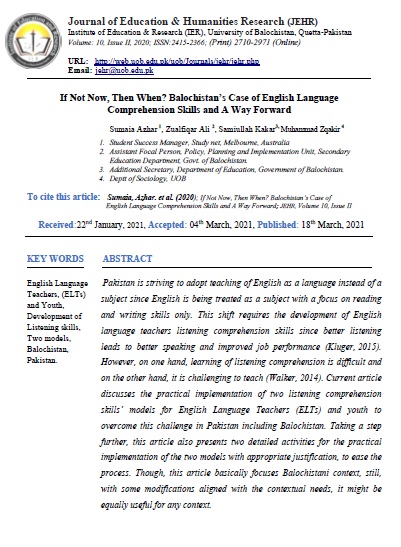If Not Now, Then When? Balochistan’s Case of English Language Comprehension Skills and A Way Forward
Keywords:
English Language Teachers 9ELTs) and youth, Development of Listening skills, Two models, Balochistan, Pakistan.Abstract
Pakistan is striving to adopt teaching of English as a language instead of a subject. This shift requires the development of English language teachers listening comprehension skills since better listening leads to better speaking and improved job performance (Kluger, 2015, May 29. However, on one hand, learning of listening comprehension is difficult and on the other hand, it is challenging to teach (Walker, 2014). Current article discourses the practical implementation of two listening comprehension skills’ models for English Language Teachers (ELTs) and youth to overcome this challenge in Pakistan including Balochistan. Taking a step further, this article also presents two detailed activities for the practical implementation of the two models with appropriate justification, to ease the process. Though, this article basically focuses Balochistani context, still, with some modifications aligned with the contextual needs, it might be equally useful for any context.
References
Abeywickrama, P. (2012). Rethinking traditional assessment concepts in classroom-based assessment. The Catesol Journal, 2.13, 205-213.
Breaking news english. (2018). Thai soccer boys cave rescue planned. Retrieved from https://breakingnewsenglish.com/1807/180705-thai-cave-rescue-l.html
Crowe, S., Cresswell, K., Robertson, A., Huby, G., Avery, A., & Sheikh, A. (2011). The case study approach. BioMedCentral, 4-9. Retrieved from https://www.researchgate.net/publication/51252479_The_Case_Study_Approach
DAWN. (2020, December). Balochistan okays education plan 2020-25. DAWN [Quetta]. Retrieved from https://www.google.com/amp/s/www.dawn.com/news/amp/1595842
Goundar, S. (2019). (PDF) Chapter 3 - Research Methodology and Research Method. Retrieved from https://www.researchgate.net/publication/333015026_Chapter_3_-_Research_Methodology_and_Research_Method
Government of Pakistan, Ministry of education. (2006). National curriculum for English language Grades I-XII. Islamabad: Author.
Govt. Of Pakistan. (2010, April). Constitution (Eighteenth Amendment) Act, 2010. Retrieved from https://www.pakistani.org/pakistan/constitution/amendments/18amendment.html
Graham, S., & Santos, D. (2015). Teaching Listening Strategies in the Second Language Classroom. In Strategies for Second Language Listening. (pp. 41-52). London, England: Palgrave Macmillan.
Jayaraman, S., & Thaur, V. (n.d.). Efl assessment: assessment of speaking and listening. In R. Al-Mahrooqi, C. Coombe, & F. Al-Maamari (Eds.), Revisiting EFL assessment [Pdf] (pp. 133-150). Retrieved from https://link-springer-com.ezproxy.lib.monash.edu.au/content/pdf/10.1007%2F978-3-319-32601-6_9.pdf
Kluger, A. (2015, May 29). Listening and its enemies [Video file]. Retrieved from http://www.globallisteningcentre.org/https://www.youtube.com/watch?time_continue=1029&v=iR-jlgWE9GQ
Language policy program education policy division education department Council of Europe. (2018). Common European framework of reference for languages: learning, teaching, assessment Companion volume with new descriptors. Retrieved from Council of Europe website: http://website: https://rm.coe.int/cefr-companion-volume-with-new-descriptors-2018/1680787989
Learn/Practice english with movies. (2015, November 13). The Incredibles [Video file]. Retrieved from https://www.youtube.com/watch?v=Rnwwo9Zol6w
Learn/Practice english withmovies. (2015, November 14). The lord of the rings [Video file]. Retrieved from https://www.youtube.com/watch?v=pt2atk-5_yQ
Ling, Bernadette, Kettle, & Margaret. (2011). Rethinking comprehension and strategy use in second language listening instruction. TESOL in Context, 21(1), 5-22. Retrieved from https://search-informit-com-au.ezproxy.lib.monash.edu.au/documentSummary;dn=632528770726002;res=IELAPA
listening. (2015). In J. Harmer (Ed.), The practice of English language teaching (5th ed., pp. 336-359). Harlow, England: Pearson Education.
Renadya, W. A. (2011). Extensive listening in the language classroom. In H. P. Widodod & A. Cirocki (Eds.), Innovation and creativity in ELT methodology (pp. 28-41). New York: Nova Science Publisher.
Secondary Education Department, Government of Balochistan. (2020). Balochistan education sector plan (BESP) 2020-25. Author.
Solak, E., & Erdam, G. (2016). Teaching listening skills. In E. Solak (Ed.), Teaching language skills for prospective teachers (pp. 29-44). ankara: Nisan Hitabevi.
Wagner, J. (2015). Designing for language learning in the wild: creating social infrastructures for second language learning. In T. Cadierno & S. W. Eskildsen (Eds.), Usage-based perspectives on second language learning (pp. 75-101). Retrieved from
Walker, N. (2014). Listening: the most difficult skill to teach. Encuentro, 23, 167-175. Retrieved from http://www.encuentrojournal.org/textos/Walker_LISTENING%20.pdf




